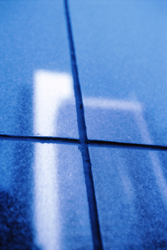Reflective nanotech tiles save energy
Newly discovered nanocrystalline materials are extremely reflective, particularly in the heat-emitting, near-infrared (NIR) spectrum. Their incorporation into building surfaces could reduce the amount of energy needed to cool buildings. The EU-funded COOL-COVERINGS(opens in new window) project aimed to develop a range of non-white reflective surfaces that could be easily and quickly brought to market. Specifically, the project produced a tile, a range of paints and a bitumen coating for roofs. Project members started by investigating the market and industry for reflective coatings in order to understand the needs to be met. Researchers then evaluated NIR-reflective nanocrystalline materials. Next, the appropriate material was manufactured and incorporated into the normal industrial process for tile and paint production as a 'cool' pigment. The prototypes were installed in a demonstration building, and showed a 4–7 % decrease in energy use over a 12-month period. The three products are now close to industrial scale-up: the roof membranes and cool paints are about to appear in commercial catalogues, while the production line for the roof tiles needs some fine tuning.







